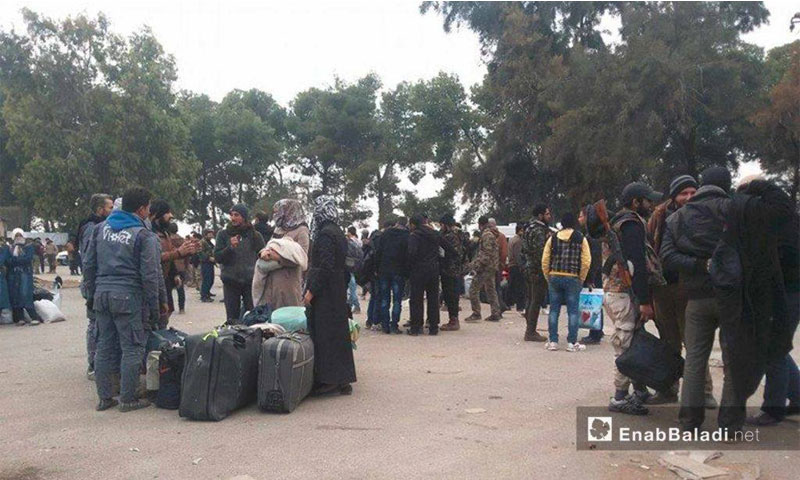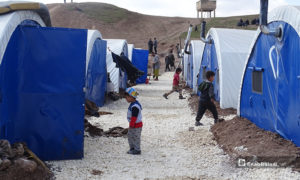
Al-Assad Close to Destroying Armed Opposition in Damascus and its Countryside

“By the beginning of 2017, Damascus and its countryside will be cleared of weapons and fighters,” is a phrase much repeated by Syrian regime analysts, supporters and media outlets in recent weeks, especially after the “wave of reconciliation” with opposition factions in Damascus and its countryside is back in the spotlight once more.
The previous agreements cleared most of the cities returning to the “national fold” of “weapons and fighters”, as the regime and its supporters refer to them. The factions left these areas after being given the choice of either “an all-out war” or handing over their weapons and normalizing their status or leaving for Idlib in northern Syria.
Thousands of Fighters from Al-Tel and Khan Al-Shih
The most recent reconciliations took place in the city of al-Tel in the rural outskirts of Damascus on 2 December. It led to the evacuation of thousands of fighters with their families aboard 45 buses heading to Idlib in northern Syria.
The agreement was reached with the regime last week after al-Assad forces intensified their bombing of the city using explosive barrels and attempts to storm the city where around 700,000 people – both original inhabitants and displaced persons from surrounding towns – live. The high civilian population and intensified offensive prompted opposition fighters to accept the reconciliation.
The fate of most of the youth (of mandatory military service age) who refused to go to Idlib remains unknown. They face two choices – either leaving the country after the six-month period set by the regime for them to sort out their status, or joining the regime’s official ranks and fighting on the frontline or joining a military division such as the National Defense Force or al-Qalmoun Shield, which was formed from militias belonging to the regime from the cities and towns of al-Qalmoun.
Prior to al-Tel, the regime and the opposition factions reached agreements in the towns of Khan al-Shih and Zakia in the western suburbs of Damascus. Around 4,000 people left for Idlib with their families in two groups, the last of which was on 1 December. They were transported in 65 buses each carrying 35 persons after waiting for 25 hours, according to sources inside the town.
The Regime’s Plan for Years
The regime has worked for years on a strategy that began by forming a ministry in 2012 called the Ministry for National Reconciliation Affairs under the Minister Ali Haider. The regime began spreading the idea that the only way out of the “crisis” was reconciliation. It began imposing ceasefires on various cities and towns close to Damascus such as Barzah al-Balad, al-Qaboun and Qudsaya, with the condition that military operations must be halted in exchange for food being allowed to enter these areas.
In light of the regime’s military advancement given the international community’s inability to stop the regime’s practices, the regime increased its demands. It no longer accepts just a truce but wants complete control over the cities, especially after it managed to take control of the city of Daraya in August 2016.
After a siege that lasted four years in August 2016, the regime managed to come to an agreement with opposition fighters under which the city of Daraya was emptied. After Daraya, which had provided a protective shield against reconciliation, other areas began to surrender, beginning with Muadmiyat, Khan al-Shih and other towns in western Ghouta, in addition to Qudsaya, al-Hamah and al-Tel.
The regime now turns its gaze to reaching similar agreements in Barada Valley, Rankous and the remaining areas of al-Qalamoun, according to Ali Haider, the Minister for National Reconciliation Affairs, in a statement to the pro-regime “al-Watan” newspaper last week.
Activists report that meetings are being held between the regime and the reconciliation committees in areas south of Damascus (the towns of Babbila, Yalda, Beit Sahm, Hayy al-Qadam and al-Aasali), which have been subject to ceasefire agreements with the regime for over 24 months, to include those towns as examples.
“Forgiveness”… A “Baathist” Initiative to Clear Eastern Al-Ghouta of Weapons
In eastern al-Ghouta, which is considered the main center for opposition forces in the rural outskirts of Damascus, the Damascus Countryside Branch Leadership of the governing Baath Party issued a decision on 27 November to nominate 30 party members in eastern al-Ghouta to communicate with the people of al-Ghouta to empty the area of opposition factions.
Enab Baladi obtained a copy of the four-page decision, which included the following: “The people of the town of eastern al-Ghouta who are present in Damascus City have launched an initiative entitled ‘Forgiveness’, with the aim of making eastern al-Ghouta a calm weapon-free area and achieve the ideal living conditions for all its people.”
According to the decision, the initiative covers the cities and towns of Kafr Batna, Arbin, Beit Sawa, Jisreen, Hamoriyet, Saqba, Hazet, Zamelka, Hutitat al-Turkman, Shebaa, Zabadani and Deir al-Asfour. The committee’s decision did not mention the city of Douma or include any of its residents in reaching the desired “reconciliation”.
The proposed mechanisms to implement the decision are “the formation of liaison committees composed of the people of eastern al-Ghouta who are outside the al-Ghouta area, to promote forgiveness, work to end tensions and protect all the people of Ghouta regardless of their affiliation.” The agreement also requires “the formation of civil committees composed of the people of al-Ghouta who are present inside the towns of eastern al-Ghouta and who have social, familial and moral influence and are close to the armed groups. These committees must meet with the committees of the people of al-Ghouta based outside the al-Ghouta area who are close to the authorities in charge of reconciliation to discuss all issues pertaining to the work of these committees, and all must meet with the relevant authorities in the government, security forces and army.”
Another mechanism mentioned in the decisions is for “all the committees, inside and outside al-Ghouta to dialogue with all the armed factions regardless of their type, affiliation or name, and to work with them to form a committee of armed fighters and opposition actors. The committees must set up a meeting between the aforementioned and concerned parties to begin negotiations to discuss all issues and find solutions for any proposals to reach a situation in eastern al-Ghouta similar to that reached in Qudsaya, al-Hamah and Muadmiyat.”
Based on the negotiations, the following will be achieved, “All foreign fighters will be evacuated from all towns in eastern al-Ghouta regardless of their affiliation, with the knowledge and under the supervision of committees formed for that aim in those towns. They will leave with their individual weapons.” The decision also calls for “normalizing the status of all wanted persons and fighters with their weapons and settling the question of weapons similar to what happened in Qudsaya and al-Hamah. Those who do not want to normalize their status will be evacuated to Idlib.”
The decision gives “all those who have not reported for mandatory military service or have not postponed their call to service a period of six months to resolve their status.” In addition, “All roads will be opened, and all products and aid will be allowed to enter.”
The committee pledges “to allow all internally displaced persons to return to their towns and villages immediately and to open all roads, with the remaining residents in each town staying in their houses. All are expected to participate in defending their town and all are equal in rights and duties.”
Damascus Countryside Provincial Council Refuses “Reconciliation”
The Damascus Countryside Provincial Council in al-Ghouta and the councils under its authority issued a statement on 1 December rejecting the “reconciliation” initiative. In the statement they said, “Eastern al-Ghouta is still raising its weapons to liberate the country from the tyrannical forces that have attacked it.”
The statement added, “The scale of the sacrifices and blood spilt in eastern al-Ghouta make it imperative that our morale remain high at all times. Regarding the ongoing rumors and whisperings about meetings between persons representing the criminal regime and some people in eastern al-Ghouta, the local councils and the Provincial Council have no knowledge of these meetings.”
The Council confirmed that it did not participate in these meetings, “We totally reject them, and whoever seeks such meetings is a puppet of the traitorous sectarian regime and world order, which has ignored the righteous and sided with the corrupt.”
Some analysts see that the regime is on its way to regaining control over Damascus and its countryside through these reconciliations, in light of the regime and its supporters exploiting the “victories” they are achieving on Syrian territory, the withdrawal of opposition forces and the preference of civilians for reconciliation over military confrontation after six years of suffering. This promises to usher in a new phase of uncertainty for the Syrian people.
if you think the article contain wrong information or you have additional details Send Correction
النسخة العربية من المقال
-
Follow us :
Most viewed
- Syrians pack their bags in Turkey
- After European call to engage with Syrian regime, Italy appoints ambassador to Damascus
- Syrian pressures prevent Omar al-Aroub from attending Paris Olympics
- Turkey and Russia discuss resuming patrols on M4 highway
- After Baraa Qaterji’s elimination, Is Syrian regime replacing its economic façade?

















 A
A
A
A
A
A








 More Uncategorized
More Uncategorized